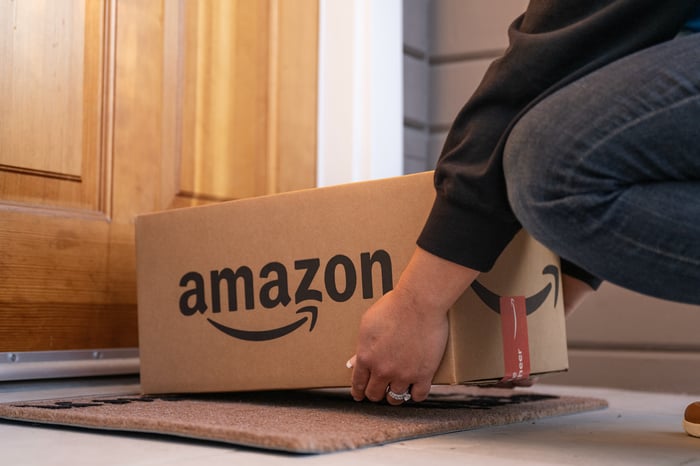2 Reasons to Buy Amazon (AMZN) Stock Like There's No Tomorrow

Key Points
The stock won't deliver another 100-bagger for investors, but it can still beat the market.
Amazon's ability to try new things is its greatest competitive advantage.
Automation in fulfillment centers is contributing to growth in the company's profits.
Amazon (NASDAQ: AMZN) was one of the supreme growth stocks to own over the last 20 years. The expansion from e-commerce to cloud computing and other services made investors a lot of money. A $1,000 investment in 2005 would be worth around $110,000 today.
The problem for investors today is that Amazon has grown into a massive business, with trailing revenue of $670 billion. The law of large numbers will naturally make it more challenging to sustain the level of revenue growth that drove those returns. However, Amazon continues to invest in cutting-edge technologies that can make shareholders more money.
Where to invest $1,000 right now? Our analyst team just revealed what they believe are the 10 best stocks to buy right now. Learn More »
Let's explore two important reasons Amazon stock is worth buying today.

Image source: Amazon.
1. Amazon's risk-taking culture is its greatest strength
Over the last 30 years, Amazon has risen from a simple online seller of books to one of the leading tech companies in the world. Most businesses lack the risk-taking culture to make bold bets. Amazon would have still delivered great returns for investors sticking to its core e-commerce operation. While it has misfired a few times, it has proven time and again its ability to capitalize on new ventures.
Founder Jeff Bezos saw the e-commerce opportunity well before Walmart and other retail leaders. Because of Amazon's internal infrastructure needs to support the growth of its online store, it also recognized the opportunity in cloud services well before Microsoft. To this day, Microsoft's cloud business is still second to Amazon Web Services in the cloud market, a $116 billion revenue-generating business.
Again, Amazon was ahead of the curve when it acquired Kiva Systems in 2012, a leading robotics company. Investments in robotics and cloud computing has created a flywheel of artificial intelligence (AI)-driven innovation that is impacting Amazon's entire business.
For example, automation in its fulfillment centers is driving substantial cost reductions for the e-commerce business, and it's also helping deliver packages to customers at record speed. This is driving the expected outcome, where faster delivery times encourage customers to shop more frequently, which solidifies Amazon's competitive moat in e-commerce.
As it turns out, Amazon knew what it was doing making all these seemingly random investments in different businesses years ago. The willingness to experiment and take risks is the most important reason investors should buy the stock. You can bet that Amazon won't rest on its laurels like Walmart did, but instead, continue to embrace new technologies and ideas to play the role of disruptor.
2. Solid financials strengthen Amazon's competitive advantage
It's no coincidence that with Amazon achieving record delivery speeds, its sales growth notched a significant improvement last quarter. Sales from online stores grew 10% year over year -- the fastest growth since Q3 2022. With Amazon also seeing consistent double-digit revenue growth in other services like cloud and advertising, its total revenue grew 13% over the year-ago quarter.
Improving revenue growth could lift the stock over the next few years, but there's another, potentially more impactful, catalyst to watch. Retail sales make up less than half of the business. Most of Amazon's revenue is coming from non-retail services that generate much higher profit margins. Along with the cost savings from automation, the growth in high-margin services contributed to the phenomenal increase in its operating income over the last three years, which improved from $15 billion on a trailing-12-month basis in Q2 2022 to $76 billion as of Q2 2025.
This strong growth in profits still has room to play out. For example, Amazon has increased the number of robots in its warehouses from over 750,000 to more than 1 million within the last year. Its DeepFleet AI model is making these robots smarter at identifying optimal routes in warehouses, resulting in a 10% increase in travel speed. It was even reported in June that Amazon plans to test using humanoid robots to deliver packages, which could result in even greater cost efficiencies over time.
What all this means is that investors can count on Amazon to constantly improve customer service, while generating a high return on capital that ultimately grows the value of the company for shareholders. With Wall Street analysts still projecting the company's earnings to grow at an annualized rate of 17%, the stock can still outperform the broader market over the next several years.
Should you invest $1,000 in Amazon right now?
Before you buy stock in Amazon, consider this:
The Motley Fool Stock Advisor analyst team just identified what they believe are the 10 best stocks for investors to buy now… and Amazon wasn’t one of them. The 10 stocks that made the cut could produce monster returns in the coming years.
Consider when Netflix made this list on December 17, 2004... if you invested $1,000 at the time of our recommendation, you’d have $661,694!* Or when Nvidia made this list on April 15, 2005... if you invested $1,000 at the time of our recommendation, you’d have $1,082,963!*
Now, it’s worth noting Stock Advisor’s total average return is 1,067% — a market-crushing outperformance compared to 190% for the S&P 500. Don’t miss out on the latest top 10 list, available when you join Stock Advisor.
*Stock Advisor returns as of September 22, 2025
John Ballard has no position in any of the stocks mentioned. The Motley Fool has positions in and recommends Amazon, Microsoft, and Walmart. The Motley Fool recommends the following options: long January 2026 $395 calls on Microsoft and short January 2026 $405 calls on Microsoft. The Motley Fool has a disclosure policy.







